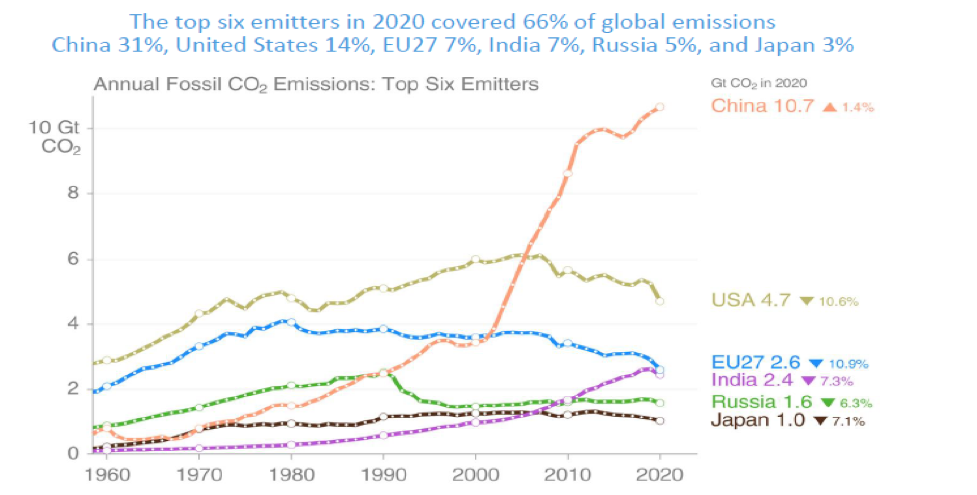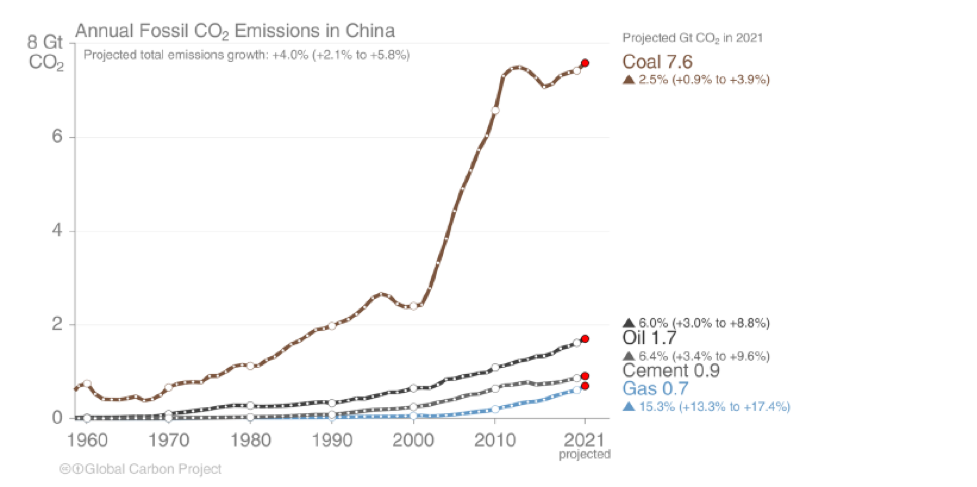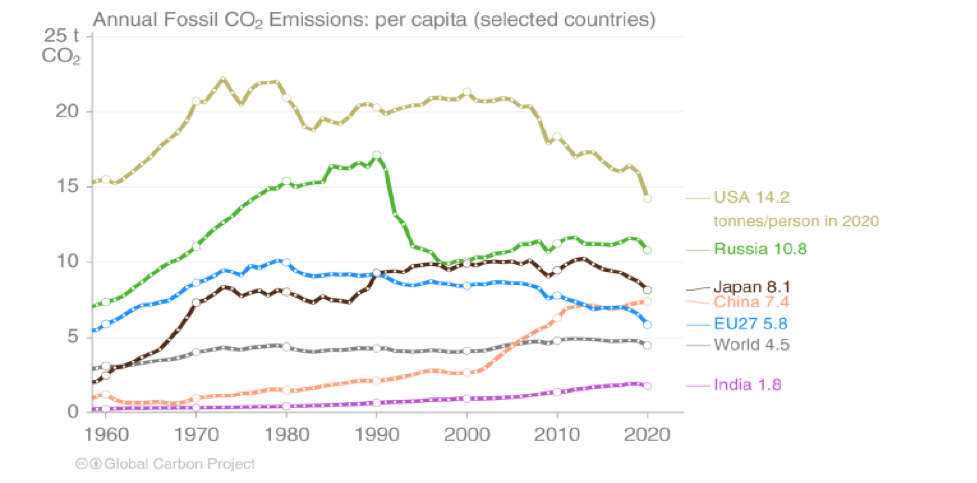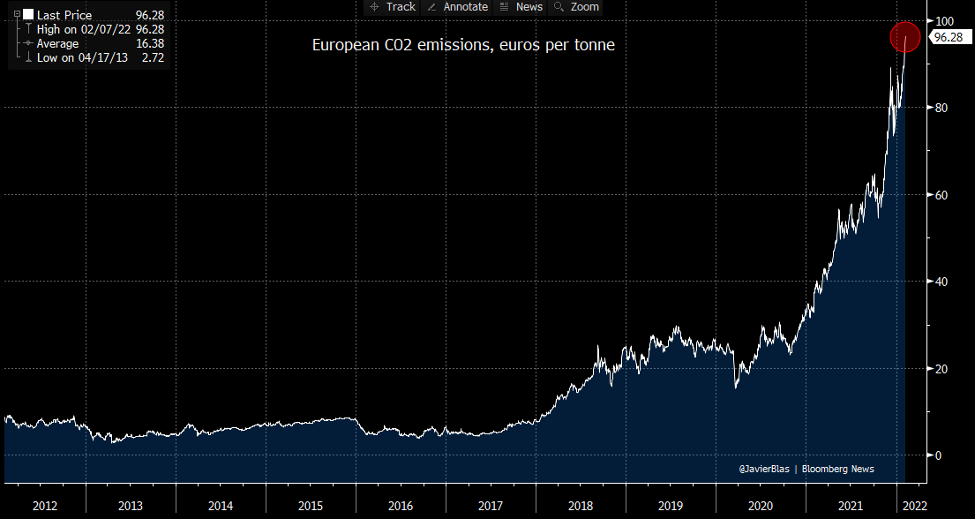China’s carbon dioxide emissions in 2020 were more than that of the United States, the European Union, and India combined. In 2020, China’s carbon dioxide emissions were 10.7 billion metric tons compared to 9.7 billion metric tons for the next 3 largest emitters combined. Since 2000, China’s carbon dioxide emissions grew by a factor of 3. They increased 1.4 percent in 2020, while most other countries saw a decrease in emissions in 2020 due to lockdowns caused by the coronavirus. In 2020, carbon dioxide emissions were down 10.6 percent in the United States, 10.9 percent in the European Union and 7.3 percent in India. China’s carbon dioxide emissions in 2021 are expected to increase by 4 percent to 11.1 billion metric tons, contributing to the 4.9 percent growth in worldwide emissions, which are expected to reach 36.4 billion metric tons.
Source: https://www.globalcarbonproject.org/carbonbudget/21/files/GCP_CarbonBudget_2021.pdf
China’s carbon dioxide emissions come principally from coal, which is used extensively for electric generation and in industrial processes in China. China’s increased demand for electricity could bring development of up to 150 gigawatts of new generation coal capacity by year-end 2025, putting China’s known coal-fired generation capacity at 1,230 gigawatts—about 6 times the U.S. coal-fired generating capacity. China already accounts for over half of all global coal-fired electricity output. Coal consumption is expected to produce over 70 percent of China’s carbon dioxide emissions in 2021 (a growth rate of 2.5 percent from 2020), followed by oil consumption at a distant 16 percent. Coal consumption also is expected to produce over 70 percent of the carbon dioxide emissions in India, with oil consumption also coming in at a distant second.
Source: https://www.globalcarbonproject.org/carbonbudget/21/files/GCP_CarbonBudget_2021.pdf
The graph below shows carbon dioxide emissions per capita. China’s per capita carbon dioxide emissions at 7.4 metric tons in 2020 are higher than those for the European Union at 5.8 metric tons and close to Japan’s 8.1 metric tons. The United States still has the highest carbon dioxide per capita emissions of this group at 14.2 metric tons, but those emissions have been dropping since the early 1970s. Russia is second with 10.8 metric tons of carbon dioxide emissions per capita. From 2000 to 2020, U.S. energy consumption per capita declined by 21 percent, while per capita energy consumption in the European Union only fell by 17 percent. Americans are doing more to reduce energy consumption than their European counterparts.
Source: https://www.globalcarbonproject.org/carbonbudget/21/files/GCP_CarbonBudget_2021.pdf
The United States reduction in carbon dioxide emissions is exemplary because it has occurred without a carbon policy such as a cap and trade program or a carbon tax, unlike the European Union, which implemented a cap and trade program in 2005. The carbon price in the European Union has recently increased substantially to €96.28 per metric ton ($109.91 per metric ton). The EU Emissions Trading Scheme (ETS) is the world’s largest greenhouse gas trading program. By 2019, the system covered more than 15,000 factories, power stations and other installations in 31 countries, including EU members, the United Kingdom, Iceland, Norway and Liechtenstein.
Source: https://twitter.com/JavierBlas/status/1490775803629641731/photo/1
Conclusion
China is by far the largest emitter of carbon dioxide emissions in the world. Despite China’s commitment to the Paris Climate Accord, China’s Xi Jinping recently indicated that the country’s low-carbon goals should not come at the expense of energy and food security or the “normal life” of ordinary people. China sees pledges to reduce carbon dioxide emissions as a risk to jobs and economic growth, which they have prioritized. Xi was quoted as saying, “Reducing emissions is not about reducing productivity, and it is not about not emitting at all, either.” Xi also said, “We must stick to the overall planning and ensure energy security, industrial supply chain security and food security at the same time as cutting carbon emissions.” These are words that the Biden administration needs to consider, as its anti-oil and gas policies are rapidly escalating gasoline and heating costs for millions of Americans that can least afford those increases and his anti-coal stance is eliminating a possible avenue for lowering electricity prices as coal plants retire in the United States.







